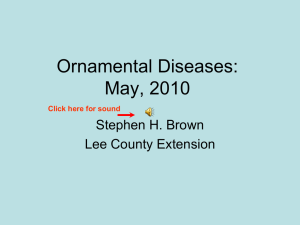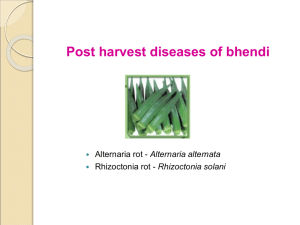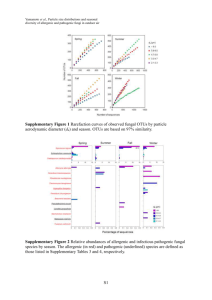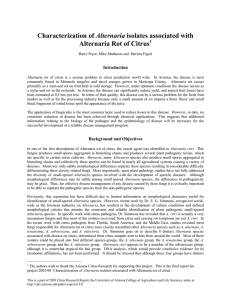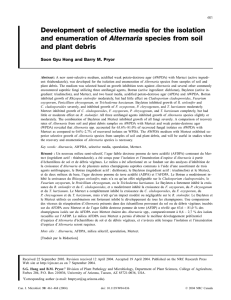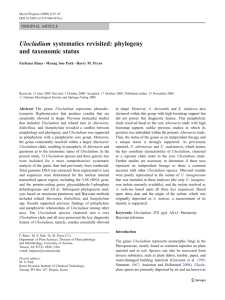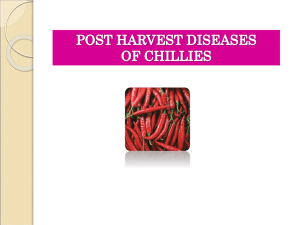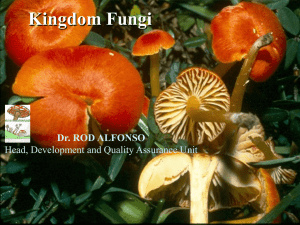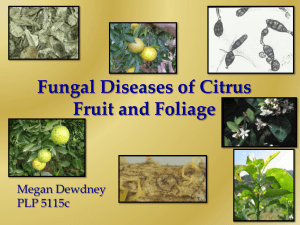Alternaria f
advertisement
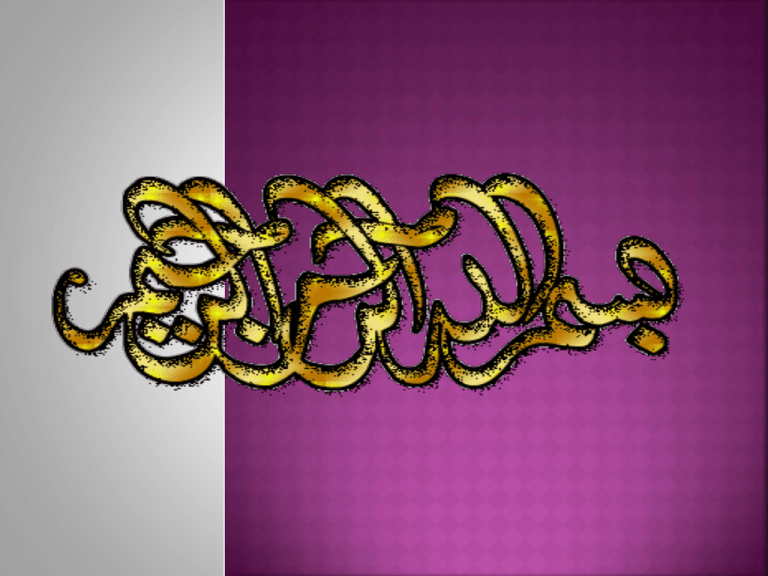
By Yomna Mazid El-Hamd Assist. Lecturer A -20- y old male patient. Solitary painful skin lesion on his scalp that slightly increase in size & undergos central necrosis & ulceration. 2 weeks duration. History of renal transplant. No history of trauma Mycophenolate mofetil. Solitary ,tender, well defined, rounded, ulcer with central eschar, surrounded by erythematous border & measure about 1 ×1 cm in diameter. Vertex. No LN++ No fever or systemic manifestation. Skin biopsy: Alternariosis is a form of phaeohyphomycosis caused by opportunistic molds of the genus Alternaria. The genus Alternaria contains several species that cause opportunistic human infections. The most frequent clinical manifestations are: Cutaneous and subcutaneous infections (74.3%). Oculomycosis (9.5%). Rhinosinusitis (8.1%). Onychomycosis. Cutaneous alternariosis is a deep mycotic infection of the skin that has mostly been described in immunocompromised hosts and occasionally in healthy individuals. Alternaria, are dematiaceous fungi, that characterized by the deposition of melanin in their cell wall. Melanin is thought to offer protection from environmental stress ( such as radiation, temperature, and hydrolytic enzymes), and to enhance the virulence and pathogenicity of the fungi. The organism lives in soil, as saprophytes and parasites of various plants. Alternaria alternata Alternaria gaisena Alternaria senecionis Alternaria arborescens Alternaria helianthn Alternaria solani Alternaria arbusti Alternaria helianthicola Alternaria smyrnii Alternaria blumeae Alternaria infectoria Alternaria tenuissima Alternaria brassicae Alternaria japonica Alternaria triticina Alternaria brassicicola Alternaria leucanthemi Alternaria zinniae Alternaria brunsii Alternaria limicola Alternaria carotiincultae Alternaria linicola Alternaria molesta Alternaria padwickii Alternaria panaxa Alternaria petroselini Alternaria radicina Alternaria raphani Alternaria saponariae Alternaria selini Alternaria carthami Alternaria cinerariae Alternaria citri Alternaria conjuncta Alternaria dauci Alternaria dianthi Alternaria dianthicola Alternaria euphorbiicola Only six species are described as human pathogens: Alternaria alternata, A chlamydospora, A dianthicola, A infectoria, A tenuissima, and A longipes. The most commonly isolated species in cutaneous alternariosis is A. alternata. Also, A. infectoria has been found to cause cutaneous lesions in few cases. The infections are not contagious. A main predisposing factor of alternariosis is immunsuppression, which may be endogenous or therapeutically induced. The most important risk factors for cutaneous and subcutaneous infections are solid organ transplantation and Cushing's syndrome. Three forms of alternariosis can be distinguished: 1. Exogenous, superficial form; 2. Exogenous, unilocular form of traumatic origin; 3. Endogenous, multilocular, disseminated form. Clinical presented as painless seborrheic eczema like lesion (localised erythema and desquamation of the skin). The localization is mostly paranasal and on the cheeks. Histological examination shows hyperkeratosis, parakeratosis, and fungal elements in the epidermis. With progression of the disease, microabcesses with fungal hyphae may be observed. This form of infection follows a traumatic introduction of the fungus into the skin (penetrating injuries). This form is found in healthy persons. The skin lesion appears as a livid-red plaque with superficial central ulceration that may reach remarkable size. The outbreak of mycosis can be as late as 10 years after the initial inoculation and might be triggered by a weakening of host defense mechanisms. The skin lesions are found on bare parts of body, legs, and arms. Usually, patients who work outdoors such as farmers, gardeners, and car drivers are affected. Histological examination of the skin biopsies of these patients reveals epidermal acanthosis and parakeratosis. A subepidermal abscess contains neutrophils. The dermis shows granulation tissue (granuloma) containing histiocytes, plasma cells, and giant cells of foreign-body types. Numerous round-shaped fungal cells and septate hyphae were present both within giant cells and extracellularly. The most common form often seen in severely immunocompromised patients. This form most probably originates from metastatic invasion of disseminated alternariosis. Underlying conditions may be the following: 1. Hypercorticism caused by Cushing disease; 2. Neutropenia as a result of a malignant condition; 3. Organ transplantation and its treatment. The entry of Alternaria species can be paranasal sinusitis, pneumonia, or wound infection after surgery. Skin manifestations appear with multiple erythematous and partially necrotic papules or papulonodular lesions approximately 1 cm in diameter. These lesions are most frequently painless, but they can be quite painful. The lesions are often found on the trunk, neck, and limbs. The patient has good general condition ( afebrile, and have no other signs of infection). Histological examination of a skin biopsy reveals various dermal granulomas, as well as an occasionally occurring central abscess. Mixed infiltrates consisting of macrophages, plasma cells, and neutrophils can be seen. No foreign body reaction is observed. Numerous round-shaped fungal cells and septate hyphae were present both within granulomatous infiltrate. Diagnosis of uncharacteristic inflammatory skin lesions in patient under immunosuppressive therapy must include an appropriate search for fungi. Among the mycoses caused by opportunistic moulds, alternariosis and fusariosis together with aspergillosis are of particular importance. A definitive diagnosis of alternariosis typically requires both histologic and mycologic analyses (direct microscopy & culture) of a biopsy sample. Cutaneous alternariosis has been classified into two types: an epidermal type and a dermal type. In the epidermal type, the organism appears in the epidermis, never invades the dermis, and hyphae are the predominant elements. In the dermal type, however, shows hyphae and yeast-like cells invading the dermal layer. Almost all reports of cutaneous alternariosis are dermal type. Numerous round-shaped fungal cells and septate hyphae were present both within granulomatous infiltrate. These structures appeared: Hyaline in H&E stained preparations. Deep red with the PAS stain. Black with a Grocott-Gomori methenamine silver stain. Skin biopsy showing round-shaped fungal cells and septate hyphae both within giant cells and extracellularly (periodic acid-Schiff stain) Septate hyphae could be methenamine-silver staining. observed with Grocott-Gomori The histological appearance of Alternaria may mimic that of Aspergillus and they are not differentiated with routinely used Gomori methenamine silver stain. However, using the Fontana-Masson stain, Alternaria may be distinguished from Aspergillus, because it contains melanin and Aspergillus does not. Direct microscopic examination after 15% to 30% KOH preparation of skin samples shows numerous dark brown septate hyphae, partially branched and sometimes few Alternaria conidia. Skin samples are cultured on Sabouraud glucose agar with and without cycloheximide at room temperature and 37C: After 3 days of incubation, the culture of the skin samples forms whitebrown colonies. No growth can be observed on cycloheximide-containing media. Morphological identification is obtained on malt agar within 48 hours. Very good growth and production of typical brown conidia in chains can be found at 30C to 33C. Potassium hydroxide wet mount of the biopsy sample showing an Alternaria conidium with characteristic clublike shape and transverse (long arrow) longitudinal arrow) septations. and (short Microscopic appearance of the slide culture at room temperature, Conidia in a chain with transverse and oblique septa were observed. Usually, cutaneous alternariosis is asymptomatic. Often, the patients do not realize the skin lesions because they are painless and non-pruritic. The course of disease lasts many weeks or months. The prognosis is good. Spontaneous remissions of patients with dermatopathic form have been published when the underlying condition improves and steroid therapy can be stopped. Fungal spread from primary cutaneous lesions has not been described. The treatment of cutaneous Alternaria infection is not standardized: Reduction of immunosuppression when possible can be sufficient to treat the lesions. In patients with small and few lesions, local excision is recommended. Treatment with cryotherapy has been successfully used for treatment of multiple lesions of cutaneous alternariosis. When complete excision or reduction of immunosuppression is not possible, oral antifungal (ketoconazole, itraconazole, fluconazole or terbinafine) are possible alternative treatments. (However, optimal antifungal dosages and duration of therapy have not been standardized). Itraconazole is suggested to be the drug of choice (in dosages ranging from 100 to 600 mg/day). Liposomal amphotericin B has also been successful in more advanced cases. Erythematous lesion on the back of the right hand. The biopsy showed pseudoepithelimatous hyperplasia and dermal infiltration of inflammatory cells. No fungal elements (Hematoxylin and eosin staining). Septate hyphae could be methenamine-silver staining. observed with Grocott-Gomori A large, lichenified lesion with central necrotic eschar on the right leg of a 17-year-old male patient 8 weeks after a penetrating injury. Potassium hydroxide wet mount of the biopsy sample showing an Alternaria conidium with characteristic clublike shape and transverse (long arrow) longitudinal arrow) septations. and (short A -33-year-old man was diagnosed with chronic myelogenous leukaemia. He underwent an allogeneic BMT from an unrelated donor. Three months later, a slightly itchy erythematous papule appeared on his left leg. During the following days, 2 similar lesions developed on his left thigh and right arm. lesions increased a little in size and the centre of the lesions became necrotic and ulcerated. Microscopic appearance of the slide culture at room temperature, Conidia in a chain with transverse and oblique septa were observed. A -58- y old male undergone a renal transplantation since 15 months and immunosuppression had been tacrolimus, mofetil & maintained with mycophenolate prednisone since then. Multiple Painless reddish-brown papules and vegetating masses with smooth surfaces over both legs extending to the ankles. No history of trauma or inoculation. 2006 Acta Dermato-Venereologica Skin biopsy showing round-shaped fungal cells and septate hyphae both within giant cells and extracellularly (periodic acid-Schiff stain) 2008 Acta Dermato-Venereologica. A 68-year-old renal transplant recipient with an unspecific painless and erythematous nodule on the lateral distal dorsal side of his right foot, which had developed within the last 2–3 months and had reached a diameter of approximately 3 cm. The patient did not recall any preceding injury or trauma at this site. He was under continuous immunosuppressive therapy with tacrolimus (4 mg daily), mycophenolate mofetil (1000 mg daily) and prednisone (5 mg daily). In the centre there are conspicuous large and thick-walled spherical periodic acid-Schiff-positive fungal elements. Some are surrounded by clear spaces
